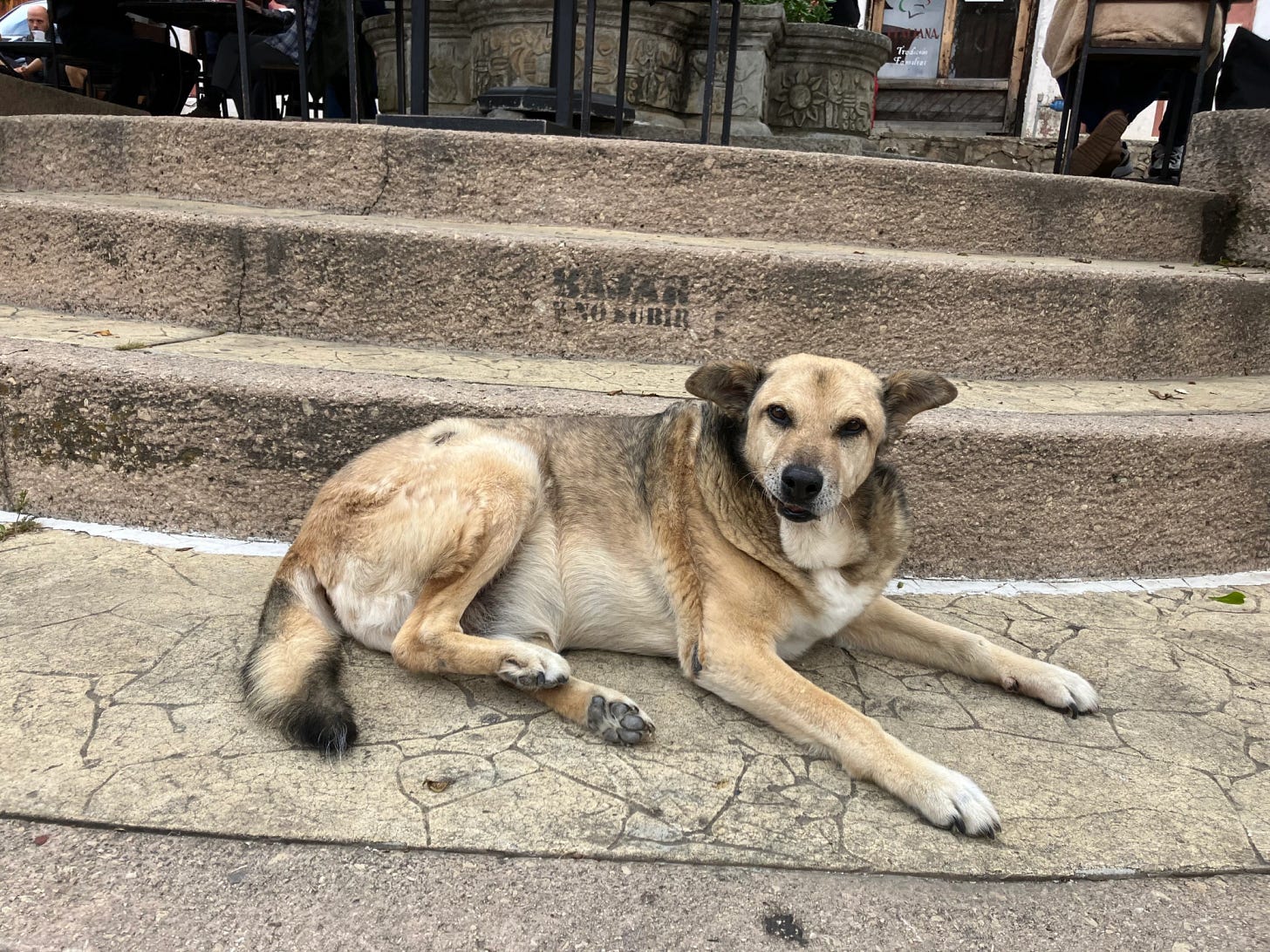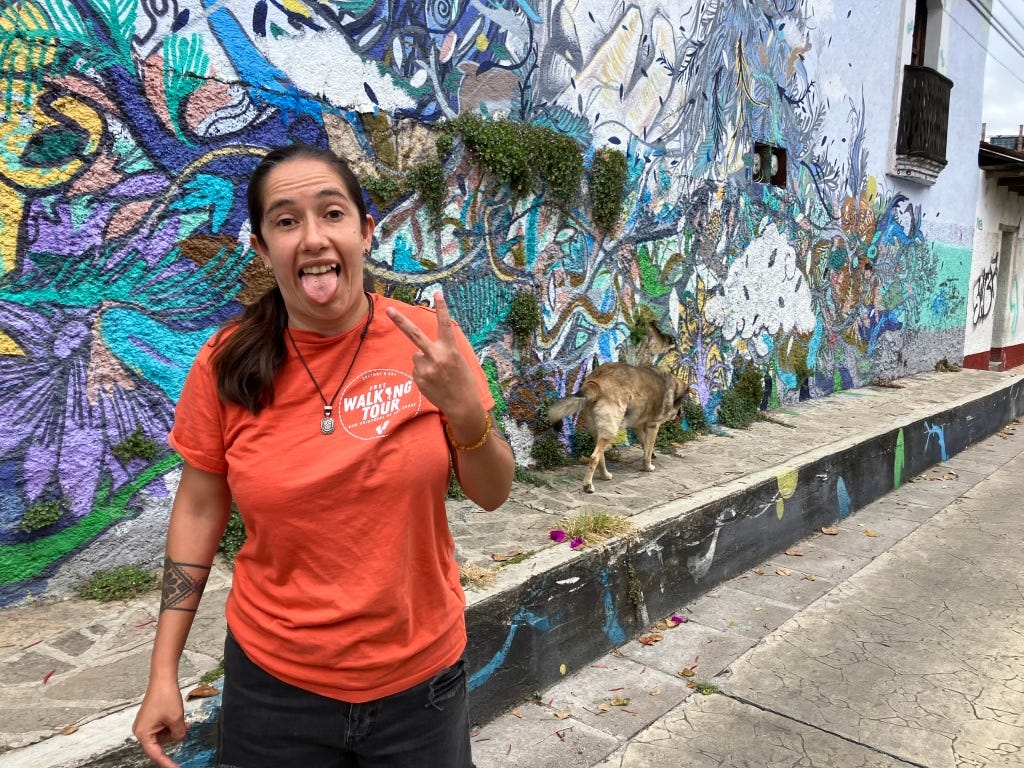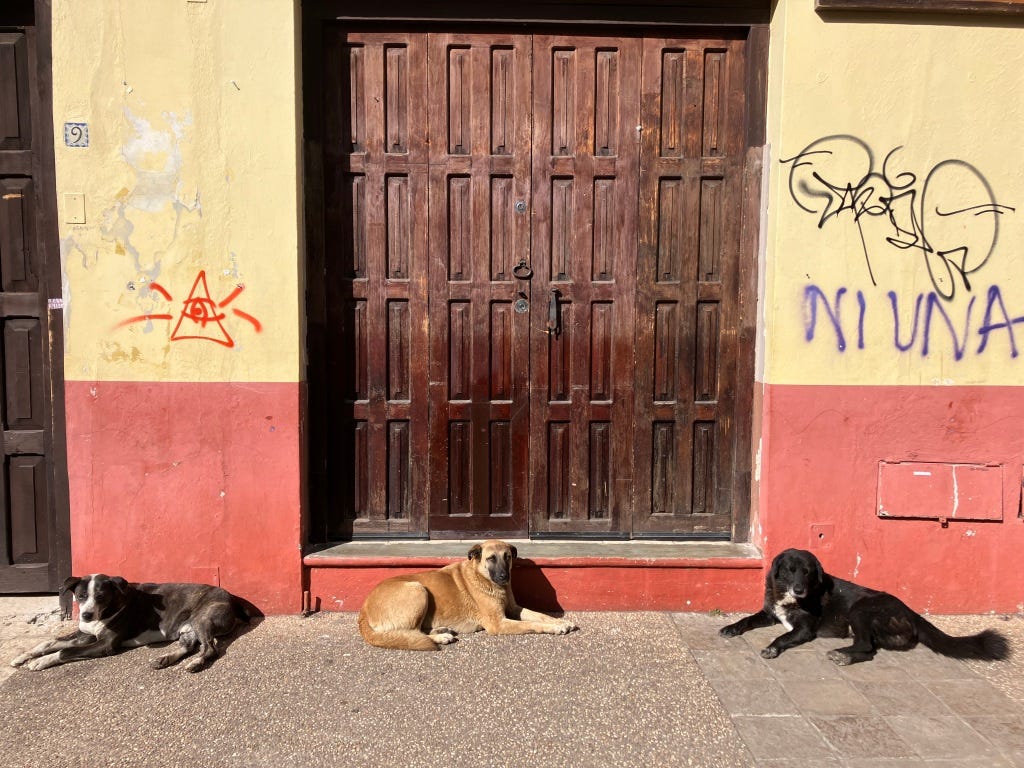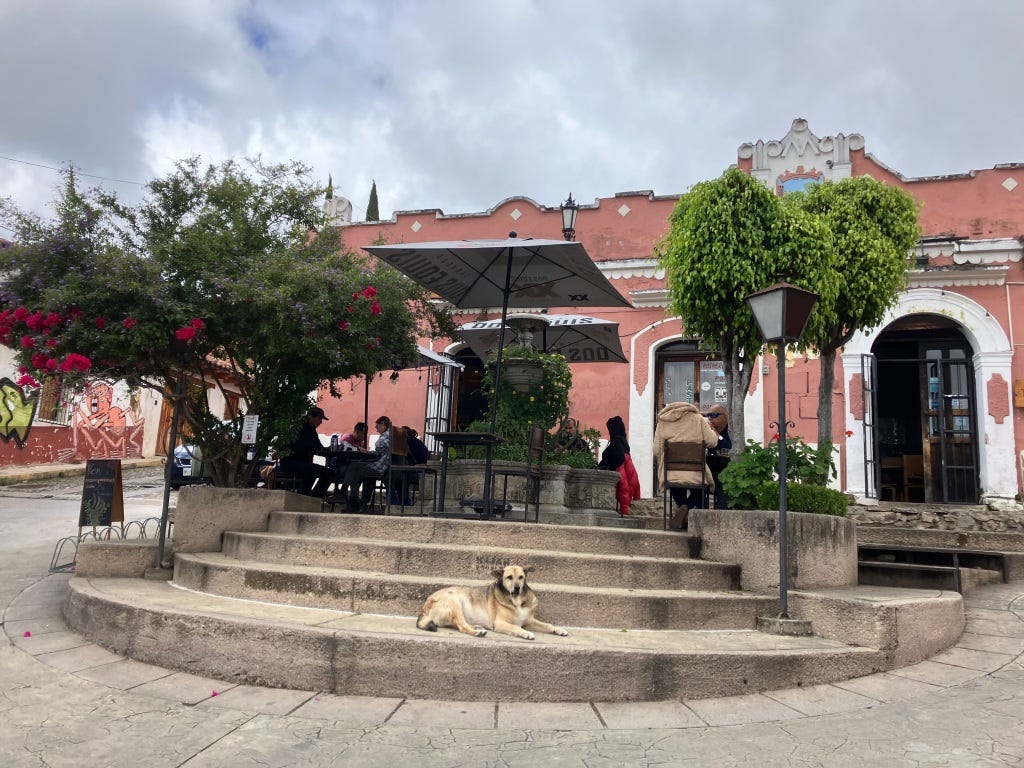Pancho
A story of loyal friendship and the power of community care
From: San Cristóbal de las Casas
Time in San Cristóbal: Since birth, age unknown
Just before 10 am most days, Pancho makes his way to the Plaza de la Paz to report for work. He plods up to the hodgepodge group of travelers. They are primarily a mix of hippie backpackers whose hair hasn’t been washed in several days and exceedingly tall Europeans with shimmery straight blonde coifs that seem to touch the sky. In the midst of them, he finds his supervisors, two Free Walking Tour guides with orange shirts and umbrellas. They welcome him with enthusiasm; he grumbles in response and flops to the ground. Another day, another peso.
Pancho is one of the many street dogs that inhabit the hilly cobblestones of San Cristóbal. He is one of the luckier street dogs, as rumor holds that he has had several temporary homes over his lifetime. Most street dogs band together in packs of two or three to find a piece of sleeping real estate, hoping that nearby humans will toss them scraps of tortillas, chicken bones, and low cost dog food. When dogs from other packs infringe on their space, they don’t hesitate to throw paws.
Street dogs here live a life of kings and paupers, all at once. Without homes, they are stuck finding shelter when the rainy season starts and brilliant blue skies turn to dirty mops being wrung out from above. Many a time, I have seen a street dog sneak into a business to avoid the rains, hoping they won’t be kicked out. Other times, they are better fed and cuddled than dogs with permanent homes; strangers learn their names, shower them with hugs, and fundraise for their vet bills.
This is especially helpful because the perils of being a street dog are very real. From swerving the motos and cars that threaten to smush them to escaping the wrath of frustrated business owners who poison them to get them off the streets, street dogs are forced to be resilient in ways that no animal ever should. How could humans be so loving and also so cruel? It’s a toxic relationship.
Many dogs, like Pancho, make themselves useful, perhaps out of love for humans, perhaps for survival. Pancho’s dad (now passed away) followed a local musician around and began singing as he played, harmonizing so impressively that passersby were stopped in their tracks. Pancho, seeking to follow in his dad’s footsteps, attempted to do the same, but could never find the right pitch to be successful. Instead, his gravelly growl turned people away. He was forced to find a new day job.
Pancho became the unofficial official walking tour dog when Lupita – the queen of San Cristobal street dogs – passed away this past February. One of my first memories when I arrived in San Cristóbal was hearing someone say, “Lupita is a bitch” because she would only greet people who gave her food. She wasn’t here to work; she was here to be served. Pancho takes a more humble approach. When the walking tour starts, he follows the group, growling at passersby whom he perceives as interfering. He takes his job as walking tour bouncer very seriously.
Despite his tendency to growl, Pancho hardly ever bites, and when he does it is upon repeated provoking and never causes real damage. When his shift is over, he sunbathes outside the coffee-tasting spot of the walking tour, a cafe called Kukulpan. Rather than urinating to mark his territory, he sheds tufts of fur on the stadium-style steps outside the cafe. He waits for water and snacks to be sent his way – payment for a hard day’s work.
Now up there in age, Pancho is taking fewer and fewer shifts. Though he may never be able to retire, he also knows how to slow down and enjoy his days. With a low growl and some shedding fur he reminds us, man’s best friend is not a pushover.
Ahora, en español…
De: San Cristóbal de las Casas
Tiempo in San Cristóbal: Desde su nacimiento, fecha de nacimiento desconocido
Casi todos los días, poco antes de las diez de la mañana, Pancho se dirige a la Plaza de la Paz para presentarse a trabajar. Se acerca a paso lento al grupo heterogéneo de viajeros. Se trata principalmente de una mezcla de mochileros hippies que no se han lavado el pelo en varios días y europeos extremadamente altos con brillantes melenas rubias y lacias que parecen tocar el cielo. En medio de ellos, encuentra a sus supervisores, dos guías turísticos a pie con camisetas naranjas y paraguas. Lo reciben con entusiasmo; él gruñe en respuesta y se deja caer al suelo. Otro día, otro peso.
Pancho es uno de los muchos perros callejeros que habitan las calles adoquinadas y montañasas San Cristóbal. Es uno de los perros callejeros más afortunados, ya que corre el rumor de que ha tenido varios hogares temporales a lo largo de su vida. La mayoría de los perros callejeros se juntan en manadas de dos o tres para encontrar un terreno para dormir, con la esperanza de que los humanos cercanos les arrojen restos de tortillas, huesos de pollo y croquetas baratas para perros. Cuando los perros de otras manadas invaden su espacio, no dudan en dar zarpazos.
Los perros callejeros viven aquí una vida de reyes y pobres a la vez. Sin hogares, se ven obligados a buscar refugio cuando comienza la temporada de lluvias y los cielos azules brillantes se convierten en trapos sucios que se escurren desde arriba. Muchas veces he visto a un perro callejero colarse en un negocio para evitar las lluvias, con la esperanza de que no lo echen. Otras veces, están mejor alimentados y mimados que los perros con hogares permanentes; los extraños aprenden sus nombres, los abrazan, y recaudan fondos para su tratamiento veterinario.
Esto es especialmente útil porque los peligros de ser un perro callejero son muy reales. Desde esquivar las motos y los coches que amenazan con aplastarlos hasta escapar de la ira de los frustrados dueños de negocios que los envenenan para sacarlos de las calles, los perros callejeros se ven obligados a ser resistentes de maneras que ningún animal debería ser. ¿Cómo pueden los humanos ser tan cariñosos y también tan crueles? Es una relación tóxica.
Muchos perros, como Pancho, se hacen útiles, tal vez por amor de los humanos, tal vez para sobrevivir. El padre de Pancho (ahora fallecido) seguía a un músico local y cantaba mientras él tocaba, armonizando de manera tan impresionante que los transeúntes se detenían en seco. Pancho, que buscaba seguir los pasos de su padre, intentó hacer lo mismo, pero nunca pudo encontrar el tono adecuado para tener éxito. En cambio, su gruñido grave ahuyentó a la gente. Se vio obligado a buscar un nuevo trabajo.
Pancho se convirtió en el perro oficial no oficial del Free Walking Tour cuando Lupita, la reina de los perros callejeros de San Cristóbal, falleció el pasado febrero. Uno de mis primeros recuerdos cuando llegué a San Cristóbal fue escuchar a alguien decir: “Lupita es una perra” porque solo saludaba a las personas que le daban comida. No estaba allí para trabajar; estaba allí para que la sirvieran. Pancho adopta un enfoque más humilde. Cuando comienza el Free Walking Tour, sigue al grupo, gruñendo a los transeúntes que percibe como un peligro. Se toma muy en serio su trabajo como portero del Free Walking Tour.
A pesar de su tendencia a gruñir, Pancho casi nunca muerde, y cuando lo hace es por provocación repetida y nunca causa daño real. Cuando termina su turno, toma el sol afuera del lugar de degustación de café del Free Walking Tour, un café llamado Kukulpan. En lugar de orinar para marcar su territorio, suelta mechones de pelo en los escalones que tienen un estilo de estadio afuera del café. Espera que le envíen agua y bocadillos, como pago por un duro día de trabajo.
Ahora que es mayor, Pancho acepta cada vez menos turnos. Aunque tal vez nunca pueda jubilarse, también sabe cómo bajar el ritmo y disfrutar de sus días. Con un gruñido bajo y algo de pelo suelto nos recuerda que el mejor amigo del hombre no es un pusilánime.








